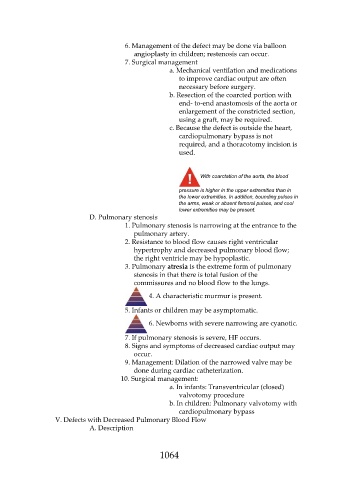Page 1064 - Saunders Comprehensive Review For NCLEX-RN
P. 1064
6. Management of the defect may be done via balloon
angioplasty in children; restenosis can occur.
7. Surgical management
a. Mechanical ventilation and medications
to improve cardiac output are often
necessary before surgery.
b. Resection of the coarcted portion with
end- to-end anastomosis of the aorta or
enlargement of the constricted section,
using a graft, may be required.
c. Because the defect is outside the heart,
cardiopulmonary bypass is not
required, and a thoracotomy incision is
used.
With coarctation of the aorta, the blood
pressure is higher in the upper extremities than in
the lower extremities. In addition, bounding pulses in
the arms, weak or absent femoral pulses, and cool
lower extremities may be present.
D. Pulmonary stenosis
1. Pulmonary stenosis is narrowing at the entrance to the
pulmonary artery.
2. Resistance to blood flow causes right ventricular
hypertrophy and decreased pulmonary blood flow;
the right ventricle may be hypoplastic.
3. Pulmonary atresia is the extreme form of pulmonary
stenosis in that there is total fusion of the
commissures and no blood flow to the lungs.
4. A characteristic murmur is present.
5. Infants or children may be asymptomatic.
6. Newborns with severe narrowing are cyanotic.
7. If pulmonary stenosis is severe, HF occurs.
8. Signs and symptoms of decreased cardiac output may
occur.
9. Management: Dilation of the narrowed valve may be
done during cardiac catheterization.
10. Surgical management:
a. In infants: Transventricular (closed)
valvotomy procedure
b. In children: Pulmonary valvotomy with
cardiopulmonary bypass
V. Defects with Decreased Pulmonary Blood Flow
A. Description
1064

